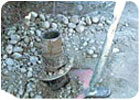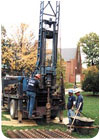
The purpose of soil borings is to provide access to subsurface soils at specified locations and depths. Soil borings also allow for installation of ground water monitoring wells and in-situ remediation systems.
The type of equipment used depends on the site geology, equipment available and monitoring design. Control of cuttings and other potentially contaminated materials at the drill site may influence drilling method selection. Depending upon equipment availability and site geology, more than one method may be combined to complete a particular monitoring well installation. Here, we'll concentrate on auger drilling.

Hollow-stem Augering
Hollow-stem auger drilling uses large-diameter (up to 14-inch outside diameter) continuous-flight augers, which mechanically excavate drilled materials from the hole. These augers are built with a large (up to 10 1/4-inch inside diameter) axial opening to allow access to the bottom of the hole without withdrawing the auger string. The augers act as temporary casing during and at the completion of drilling to facilitate the sampling of sediment and water and the installation of monitoring wells.Some advantages of hollow-stem auger drilling often make it the preferred method of installing monitoring wells. Hollow-stem auger drilling is relatively rapid - especially in shallow applications in poorly lithified to unlithified sediments. Little or no outside fluid is required in the drilling process. Though a relatively large volume of cuttings is generated, normally, it is easily contained. The volume of effluent, resulting from well-development efforts and requiring disposal, normally is lower than with some methods. Hollow-stem auger drilling readily supports thin-wall and split-tube sampling in poorly lithified sediments. Most hollow-stem rigs also support other drilling methods such as mud rotary, solid-stem auger and coring. Hollow-stem rigs are relatively simple, with few lubricated parts at positions likely to contaminate the test hole or monitoring well.
There are some disadvantages and limitations to the use of the hollow-stem auger method in the construction of monitoring wells. It is limited to drilling in poorly lithified to unlithified sediments, and to a maximum depth of about 150 feet. Shallow bedrock or other hard-to-drill materials may reduce this depth significantly. Hollow-stem augers are prone to cross-contamination of fluids within the borehole along the large annular space around the auger tubing. High hydrostatic pressures in the borehole can cause problems with sand heaving up into the augers during sampling and well-installation procedures. Wide variations in borehole size, common to auger drilling in poorly cohesive sediments, may complicate effective sealing of the annular space during monitoring-well installation. The design of hollow-stem augers produces an approximately 1-inch thick rind of smeared cuttings, which may effectively seal the borehole walls in clayish sediments. This rind may interfere with the flow of fluids to the monitoring well.
U.S. Environmental Protection Agency guidelines recommend that hollow-stem auger inside diameters be 3 inches to 5 inches greater than the outer diameter of well casings to allow effective placement of filter and sealing materials. Ideally, 2-inch diameter monitoring wells should therefore be installed within 5.5 inch I.D. or larger hollow-stem augers.
Hollow-stem auger drilling usually is appropriate in the more poorly lithified sediments. The method also is well suited to drilling in glacial drift. These sediments, however, often are composed primarily of sticky bentonitic clays that require a rig that can supply high drill-head torque to complete deeper holes. Cretaceous shale, chalk and sandstone provide for difficult hollow-stem auger drilling but often may be penetrated with larger, more powerful rigs equipped with heavy-duty augers. Sediments containing abundant large boulders may be penetrated only with great difficulty by hollow-stem methods. Other well-lithified bedrock units, such as well-cemented sediments, preclude hollow-stem drilling.

Solid-stem Augers
Solid-stem auger drilling incorporates continuous-flight augers that mechanically cut and continuously transport cuttings to the land surface. Augers for monitoring well construction must be of sufficient diameter (approx. 3-5 in. larger in diameter than the monitoring well's O.D.) to allow effective placement of well filter and sealing materials.Solid-stem augering has a number of advantages. It produces a moderate amount of easily contained cuttings, and little or no fluid is required in the drilling process. The entire surface area of the augers is accessible, facilitating complete and simplified decontamination. Thin wall and split-barrel soil sampling operations are supported. Smaller rigs than used in hollow-stem auger drilling may be used, simplifying decontamination and site maneuvering, meaning lower costs. These rigs drill relatively rapidly, especially in shallow applications. Solid-stem rigs are relatively simple, with few lubricated parts at positions likely to contaminate the test hole or monitoring well.
Solid-stem auger drilling also has some disadvantages. It can be prone to cross-contamination of fluids in the borehole along the large annular space around the auger. Like hollow-stem augers, the design of these augers produces an approximately 1-inch thick rind of smeared cuttings that may effectively seal the borehole walls in clayish sediments. This rind may interfere with the flow of fluids to the monitoring well. Solid-stem augers must be removed from the hole before any soil sampling or well installation can commence. The method, therefore, generally is limited to stable earth materials that will not collapse when the augers are removed from the hole. Saturated silts, sands and gravels, and materials below those sediment types, are not suited to monitoring well construction by this drilling method. Soil sampling during solid-stem auger drilling is labor intensive, especially in deeper holes, because the augers must be removed from the hole during each sampling procedure. Workers also are more likely to contact contaminated materials and equipment during this repeated large-scale handling of down-hole equipment.
Solid-stem auger drilling generally is restricted to the more cohesive, yet poorly lithified sediments. The method is well suited to drilling in glacial tills. These sediments primarily are composed of sticky bentonitic clays, which require high rotary-head torque to cut and transport cuttings from deeper holes. Cretaceous shale, chalk and sandstone provide for difficult auger drilling, but often may be penetrated with larger, more powerful auger rigs and heavy-duty augers. Sediments containing abundant large boulders may be penetrated only with great difficulty by solid-stem auger methods. Other well-lithified bedrock units can preclude solid-stem auger drilling.

Bucket Auger Method
Bucket auger drilling uses a rotating cylindrical bucket with cutting blades mounted on a hinged bottom to repeatedly cut and lift sediments from the hole, much like the operation of a common post-hole auger. Bucket-auger rigs may be equipped to drill holes from 10 inches to 60 inches in diameter. Boreholes for monitoring wells drilled by this method commonly are 12 inches in diameter. Bucket-auger rigs are capable of drilling to about 100 feet in depth.Bucket augering requires little or no fluid in the drilling process. The entire surfaces of the drilling tools are easily accessible, allowing complete and simplified decontamination. Though normal soil sampling tools usually are not supported, samples from the drilling process are adequate for most purposes and easily located as to position within stratigraphy of the hole. A variation of bucket-auger drilling, fashioned after the California Stovepipe method, advances casing during the drilling process. This variation greatly limits the potential for cross-contamination of fluids within the borehole. Bucket-auger rigs are relatively simple, with few lubricated parts at positions likely to contaminate the test hole or monitoring well. They are capable of quite rapid drilling rates.
Disadvantages of bucket augering include the production of a large volume of cuttings and fluids (when operating within the saturated zone). When watertight casing is not advanced concurrent with drilling, cross-contamination of fluid-bearing intervals is likely. Bucket augering generally is limited to poorly lithified but cohesive sediments, but may continue even into sand and gravel if the hole is cased concurrent with the drilling process, or if the hole is kept full of water. Even moderately lithified sediments usually are too resistant for bucket-auger rigs to penetrate.
Bucket augering generally is restricted to the more cohesive, yet unlithified sediments. The method is well suited to drilling in glacial tills. Cretaceous shale, chalk and sandstone are difficult-to-impossible to drill using the bucket-auger method. Sediments containing abundant large boulders, well-lithified sediments or igneous and metamorphic rocks preclude bucket-auger drilling.
ND
Report Abusive Comment